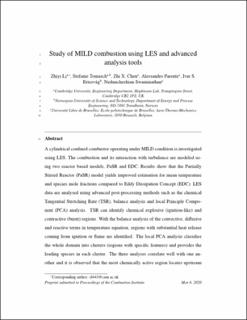| dc.contributor.author | Zhiyi, Li | |
| dc.contributor.author | Tomasch, Stefanie | |
| dc.contributor.author | Chen, Zhi X. | |
| dc.contributor.author | Parente, Alessandro | |
| dc.contributor.author | Ertesvåg, Ivar Ståle | |
| dc.contributor.author | Swaminathan, Nedunchezhian | |
| dc.date.accessioned | 2021-03-05T12:37:06Z | |
| dc.date.available | 2021-03-05T12:37:06Z | |
| dc.date.created | 2020-11-27T13:24:45Z | |
| dc.date.issued | 2020 | |
| dc.identifier.citation | Proceedings of the Combustion Institute. 2020, . | en_US |
| dc.identifier.issn | 1540-7489 | |
| dc.identifier.uri | https://hdl.handle.net/11250/2731873 | |
| dc.description.abstract | A cylindrical confined combustor operating under MILD condition is investigated using LES. The combustion and its interaction with turbulence are modeled using two reactor based models, PaSR and EDC. Results show that the Partially Stirred Reactor (PaSR) model yields improved estimation for mean temperature and species mole fractions compared to Eddy Dissipation Concept (EDC). LES data are analysed using advanced post-processing methods such as the chemical Tangential Stretching Rate (TSR), balance analysis and local Principle Component (PCA) analysis. TSR can identify chemical explosive (ignition-like) and contractive (burnt) regions. With the balance analysis of the convective, diffusive and reactive terms in temperature equation, regions with substantial heat release coming from ignition or flame are identified. The local PCA analysis classifies the whole domain into clusters (regions with specific features) and provides the leading species in each cluster. The three analyses correlate well with one another and it is observed that the most chemically active region locates upstream (in the near-field). Also, both autoignition and flame-like structures play equally important roles in MILD combustion. | en_US |
| dc.language.iso | eng | en_US |
| dc.publisher | Elsevier | en_US |
| dc.rights | Attribution-NonCommercial-NoDerivatives 4.0 Internasjonal | * |
| dc.rights.uri | http://creativecommons.org/licenses/by-nc-nd/4.0/deed.no | * |
| dc.title | Study of MILD combustion using LES and advanced analysis tools | en_US |
| dc.type | Peer reviewed | en_US |
| dc.type | Journal article | en_US |
| dc.description.version | acceptedVersion | en_US |
| dc.source.pagenumber | 10 | en_US |
| dc.source.journal | Proceedings of the Combustion Institute | en_US |
| dc.identifier.doi | 10.1016/j.proci.2020.06.298 | |
| dc.identifier.cristin | 1853397 | |
| dc.relation.project | Notur/NorStore: nn9400k | en_US |
| dc.relation.project | Norges forskningsråd: 268369 | en_US |
| dc.description.localcode | "© 2020. This is the authors’ accepted and refereed manuscript to the article. Locked until 20.9.2022 due to copyright restrictions. This manuscript version is made available under the CC-BY-NC-ND 4.0 license http://creativecommons.org/licenses/by-nc-nd/4.0/ " | en_US |
| cristin.ispublished | true | |
| cristin.fulltext | preprint | |
| cristin.fulltext | postprint | |
| cristin.qualitycode | 2 | |

